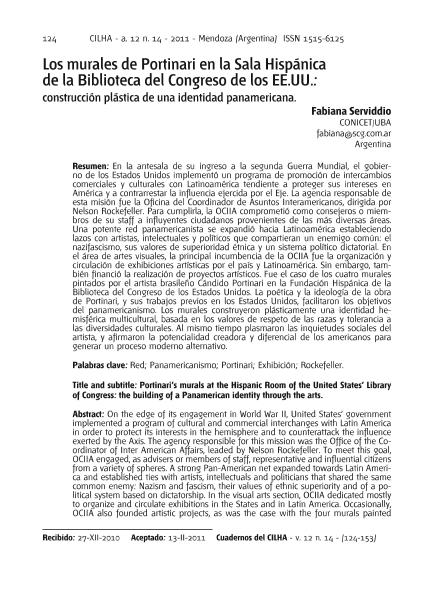Artículo
En la antesala de su ingreso a la segunda Guerra Mundial, el gobierno de los Estados Unidos implementó un programa de promoción de intercambios comerciales y culturales con Latinoamérica tendiente a proteger sus intereses en América y a contrarrestar la influencia ejercida por el Eje. La agencia responsable de esta misión fue la Oficina del Coordinador de Asuntos Interamericanos, dirigida por Nelson Rockefeller. Para cumplirla, la OCIIA comprometió como consejeros o miembros de su staff a influyentes ciudadanos provenientes de las más diversas áreas. Una potente red panamericanista se expandió hacia Latinoamérica estableciendo lazos con artistas, intelectuales y políticos que compartieran un enemigo común: el nazifascismo, sus valores de superioridad étnica y un sistema político dictatorial. En el área de artes visuales, la principal incumbencia de la OCIIA fue la organización y circulación de exhibiciones artísticas por el país y Latinoamérica. Sin embargo, también financió la realización de proyectos artísticos. Fue el caso de los cuatro murales pintados por el artista brasileño Cándido Portinari en la Fundación Hispánica de la Biblioteca del Congreso de los Estados Unidos. La poética y la ideología de la obra de Portinari, y sus trabajos previos en los Estados Unidos, facilitaron los objetivos del panamericanismo. Los murales construyeron plásticamente una identidad hemisférica multicultural, basada en los valores de respeto de las razas y tolerancia a las diversidades culturales. Al mismo tiempo plasmaron las inquietudes sociales del artista, y afirmaron la potencialidad creadora y diferencial de los americanos para generar un proceso moderno alternativo. On the edge of its engagement in World War II, United States' government implemented a program of cultural and commercial interchanges with Latin America in order to protect its interests in the hemisphere and to counterattack the influence exerted by the Axis. The agency responsible for this mission was the Office of the Coordinator of Inter American Affairs, leaded by Nelson Rockefeller. To meet this goal, OCIIA engaged, as advisers or members of staff, representative and influential citizens from a variety of spheres. A strong Pan-American net expanded towards Latin America and established ties with artists, intellectuals and politicians that shared the same common enemy: Nazism and fascism, their values of ethnic superiority and of a political system based on dictatorship. In the visual arts section, OCIIA dedicated mostly to organize and circulate exhibitions in the States and in Latin America. Occasionally, OCIIA also founded artistic projects, as was the case with the four murals painted by Brazilian artist Candido Portinari at the Hispanic Room of the Library of Congress. Portinari' s art poetic and ideology, as well as his previous work in the States, eased Pan-Americanism' s objectives. The murals built a multicultural hemispheric identity through the arts, an identity based on respect for racial and cultural diversity. At the same time, the murals reflected the artist's social concerns, and affirmed the creative possibilities of American people to produce an alternative modern process.
Los murales de Portinari en la Sala Hispánica de la Biblioteca del Congreso de los EEUU: construcción plástica de una identidad panamericana
Título:
Title and subtitle: Portinari’s murals at the Hispanic Room of the United States’ Library of Congress: the building of a Panamerican identity through the arts
Fecha de publicación:
10/2011
Editorial:
Universidad Nacional de Cuyo. Facultad de Filosofía y Letras. Centro Interdisciplinario de Literatura Hispanoamericana
Revista:
Cuadernos del Cilha
ISSN:
1515-6125
Idioma:
Español
Tipo de recurso:
Artículo publicado
Clasificación temática:
Resumen
Palabras clave:
RED
,
PANAMERICANISMO
,
EXHIBICION
,
PORTINARI
Archivos asociados
Licencia
Identificadores
Colecciones
Articulos(SEDE CENTRAL)
Articulos de SEDE CENTRAL
Articulos de SEDE CENTRAL
Citación
Serviddio, Luisa Fabiana; Los murales de Portinari en la Sala Hispánica de la Biblioteca del Congreso de los EEUU: construcción plástica de una identidad panamericana; Universidad Nacional de Cuyo. Facultad de Filosofía y Letras. Centro Interdisciplinario de Literatura Hispanoamericana; Cuadernos del Cilha; 12; 14; 10-2011; 121-150
Compartir




